News
How Russia Will Respond to NATO’s Expansion Into Finland: A Focus on Asymmetric Assets
Since months before Finland’s formal accession to the NATO alliance on April 4, which effectively overnight doubled the alliance’s borders with Russia at a time of peak tensions due to war in Ukraine, possible Russian responses to the major expansion of NATO forces adjacent to its territory have been widely speculated. One early induction of this was the announcement by Russian Defence Minister Sergey Shoigu that a new army corps would be formed in Karelia near St. Petersburg, adjacent to the Russian-Finnish border. The corps would be comprised of three motorised rifle divisions and two airborne divisions, with assets from the Russian Airborne Forces forming the centre of its fighting power. Officers cited by state media repeatedly highlighted that it was highly likely that artillery and missile forces, and particularly the Iskander-M ballistic missile system, would be at the heart of efforts to strengthen Russian forces in the area. Colonel Mikhail Khodaryonok, for one, informed RT: “It is likely that these new formations will include brigades operating Iskander-M missile systems and heavy artillery brigades carrying nuclear ammunition.”
Regarding the use of nuclear forces to compensate for conventional disadvantages, Khodaryonok added: “Given NATO’s superiority in terms of conventional arms, Moscow would do well to consider planting nuclear land mines along the state border with the alliance’s new member states.” He elaborated that “any defensive operation of this scale must be approved first. All military units must be formed, and their deployment planned out. Other workflows to implement include coordination, command and control chains, as well as all kinds of supply routes and military logistics. Naturally, the expenses associated with such an operation would be considerable. But in this case, national defence and security interests clearly take priority.”

Finland’s accession to NATO is expected to place very significant further pressure on Russian defences on its Western borders. Indeed, even preceding the formal announcement of a decision to accede, the country in December 2021 became a leading client for the F-35A fifth generation fighter when it placed an order for 64 aircraft from the United States. Developed under the Joint Strike Fighter program, the F-35 was designed primarily for offensive air to ground operations and benefits from a companion of stealth capabilities and electronic warfare capabilities which make it potentially particularly threatening to Russian air defences. The F-35 represents an especially significant threat due to the fact that all fighters of the class across the world form part of a single network, meaning their operations on Russia’s border would provide very significant targeting data to NATO members, including to American cruise missile arsenals at sea and in the air, even if Finland were outside NATO. Expansion of the Russian air defence network in the region, as well as of surface to surface assets capable of targeting airbases hosting the fighters, has been widely speculated to be in planning for the latter half of the decade when the fighters begin to be delivered.

Providing further insight into possible Russian responses, on April 3 the day before Helsinki’s formal accession to the alliance Russian Deputy Foreign Minister Alexander Grushko warned: “If other NATO members deploy their forces and equipment on Finnish territory, we will take additional steps to ensure Russia’s security.” While it remains uncertain whether there will be a significant increase in the presence of forces from other Western powers on Finnish territory, even without this the country’s membership of the alliance and F-35 acquisition alone are transformative for the security situation Russia faces on its western borders. Without the ability to respond symmetrically due to its much smaller conventional forces, it is expected that assets such as mobile ground based air defence systems and tactical ballistic missile systems will be relied on very heavily as they have been consistently in theatres ranging from Syria to Korea to confront Western forces.












